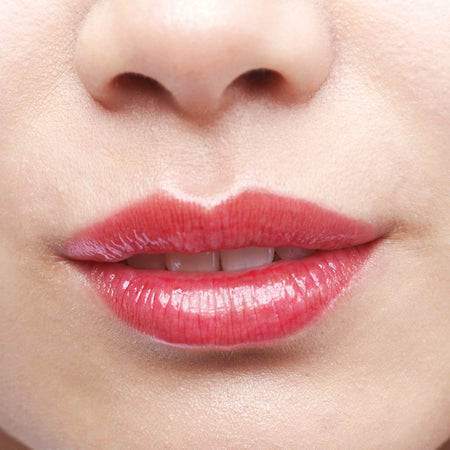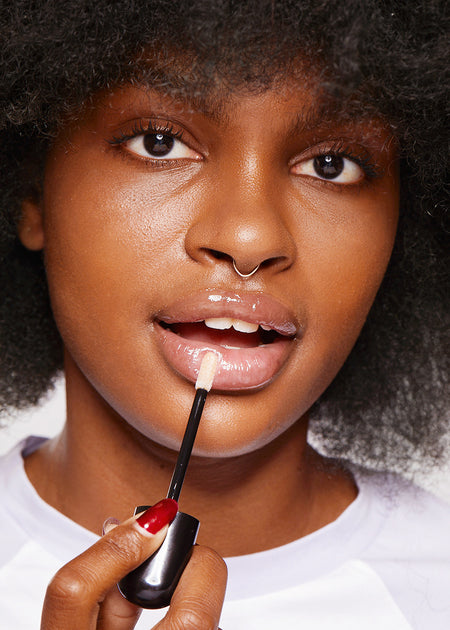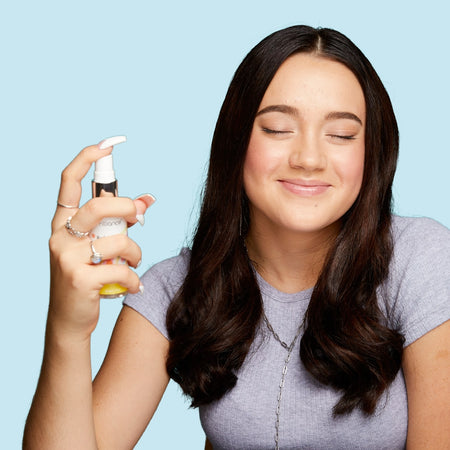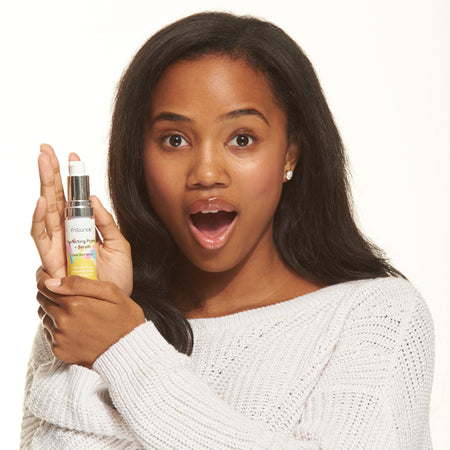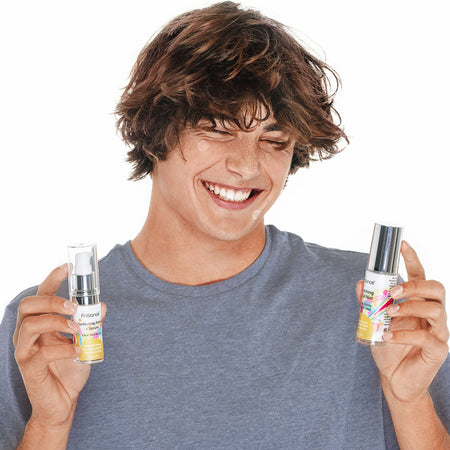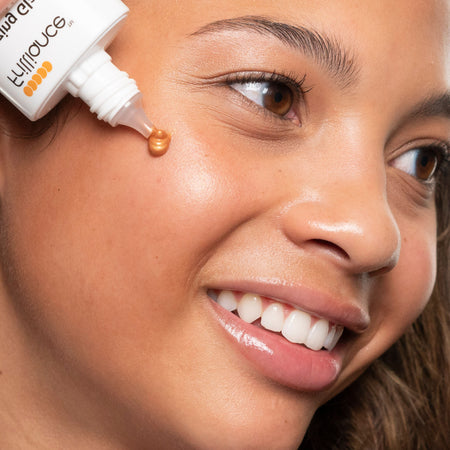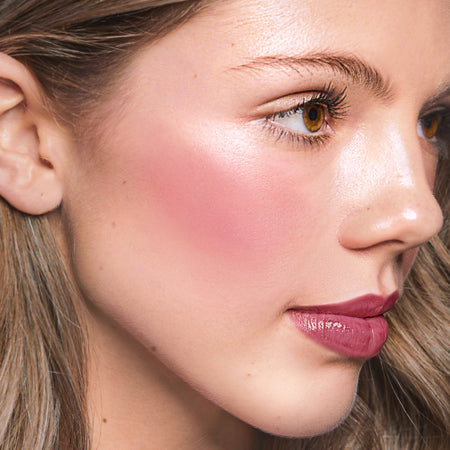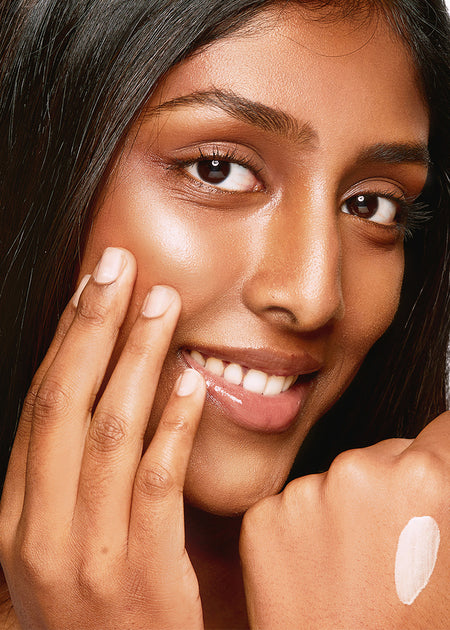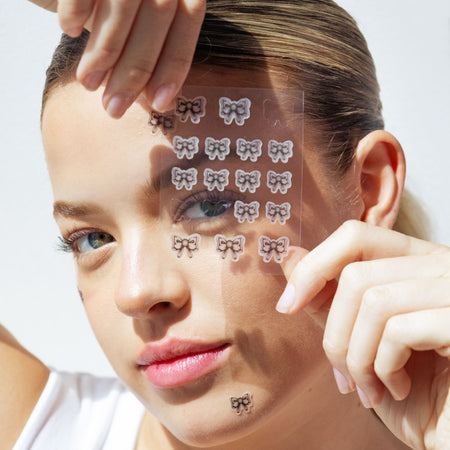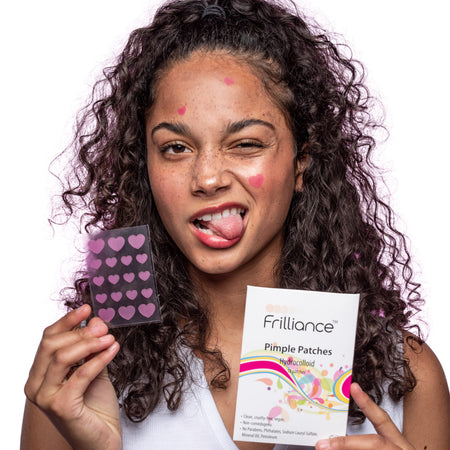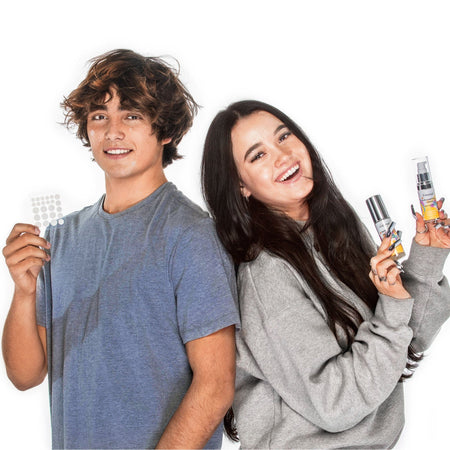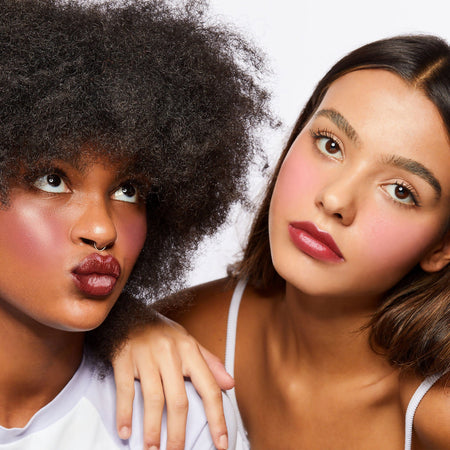| Ingredient |
Purpose |
Description |
Comedogenic Rating* |
Safety Rating** |
| Alcohol (denatured) |
Penetration enhancer |
Often maligned as a "bad" ingredient, denatured alcohol is a commonly used, relatively gentle cosmetic ingredient and, when used sparingly, is quite helpful. This kind of alcohol (a low molecular weight alcohol) breaks up skin oil and is used in some Frilliance products. For our purposes, this breaking up of oil is a good function. It allows better penetration, better delivery for the powerful, beneficial ingredients we want to get to your skin. Denatured alcohol also has the added benefit of acting as a long-lasting preservative that inhibits the growth of bacteria and nasties you DON'T want in your skin care products. A powerful ally in the battle for clear, beautiful skin.
|

0 (not listed) |
 |
| Aloe Barbadensis Leaf Juice |
Skin conditioning agent |
Hello, aloe! Aloe barbadensis is simply another name for aloe vera. Aloe vera, a succulent plant, is a natural, skin-loving ingredient whose use crosses many cultures. Rich and moisturizing, aloe also has two important hormones, auxin and gibberellins. These two hormones promote healing and help calm inflammation. Giberellin stimulates new cell growth which helps skin to heal quickly and naturally with added protection against scarring. It's why aloe is one of the most popular recommendations for treating skin damage. But you don't have to get hurt to enjoy the benefits of aloe. As a regular addition to skin care, aloe vera also helps boost the water content in your skin and leaves it hydrated without making your skin feel yucky and greasy. All of these benefits make aloe a great natural too to have in protecting and healing teen-prone skin. |

0 (not listed) |
 |
| Beeswax |
Viscosity Increasing Agent |
What's the buzz on beeswax and Frilliance? Our Neutral Bliss Lip Gloss is the only Frilliance product to use beeswax. In that lipgloss formula, beeswax is there to condition your lips and create a natural barrier which helps to seal in moisture (prevent dryness). This barrier also helps protect against environmental toxins and irritants. Thank you, bees! |

0 |
 |
| Butylene Glycol |
Skin conditioning |
An ingredient with a funny name that wants to be your everything. One of THE most common skin care and cosmetics ingredients around, butylene glycol is a gentle, face-loving ingredient that works in three ways: increased skin penetration, better product consistency, and a humectant. Some skincare ingredients you want up close and personal with your skin cells are simply too large on a molecular scale. In other words, they can't be easily absorbed because they don't fit well. Butylene glycol saves the day there. It effectively increases skin penetration and escorts other ingredients to where they'll be most helpful.
When added to liquid products, butylene glycol provides a thinner consistency making product application feel less greasy. Aaah, a delightful silky touch is the second benefit. Lastly, as a humectant, it has the wonderful ability to draw moisture TO your skin and help keep it hydrated.
|

0 |
 |
| Calendula Officinalis Flower Extract |
Skin conditioning |
Not an especially showy flower, calendula officinalis bears yellow petals around a golden flowerhead on a short, dark green stalk. Pretty basic in the looks department but calendula has been used as an herbal medicine for thousands of years. This surprising little flower has been used in making teas for calming the stomach, but nowadays it is much more common to find small amounts of calendula added to skin care products. Think of calendula as a calm ninja that sneaks up on bacteria and then captures it as it tries to give you acne. The first thing calendula does is soothe your skin. That’s important, because it isn’t just rubbing and scrubbing and irritantion that damage your skin. The skin’s nervous system can sense skin damage and will send a message to skin cells to release histamine. This is the chemical that also causes allergic reactions. It also can destroy skin that might be “held hostage” by a skin-irritant ingredient to keep it from getting into the bloodstream. If you had the stinger of a bee or a sliver in your skin, this would be a good thing, but if the problem is just having done too much rubbing and scrubbing or having used a detergent chemical on your skin, then the histamine reaction isn’t helpful. Here's where calendula enters the scene. Calendula keeps the irritation from getting worse. Calendula does its calming magic and then fights infection. It interferes with the ability of bacteria to use iron, which bacteria needs to multiply. Calendula doesn't really kill bacteria. What it does is calmly grabs bacteria and holds it hostage until your immune system can kill it with a minimum of irritation. Calendula simply helps your body as it helps your skin. Ninja flower to the rescue. |
 |
 |
| Camellia Sinensis Leaf Extract |
Antioxidant |
Green tea extract is derived from leaves of Camellia sinensis (green tea). You often hear about the health benefits you'll enjoy from sipping green tea but green tea is also a rich source of polyphenols and that's where the magic happens for teen-prone skin. Polyphenols have antimicrobial and anti-inflammatory properties. Recent studies suggest that tea polyphenols may be used for reducing sebum production in the skin and that makes green tea a powerful weapon in the battle against acne. Ongoing research shows evidence that tea polyphenols in topical formulations may be beneficial in reducing sebum secretion (helps prevent acne) and aids in the treatment of acne (fights existing acne). Go, green tea! Green tea extract is also naturally rich in antioxidants, which have a cell-protecting function. These strong antioxidants help protect the skin from the damaging effects of free radicals. Green tea extract also contains methylxanthines that stimulate skin microcirculation and boost the overall tone and health of your skin. Green tea. Great in a cup, great on your face. |

0 (not listed) |
 |
| Caprylic/Capric Triglyceride |
Emollient |
Rich, luxurious, moisture powerhouse. Derived from coconut oil and glycerin, caprylic/capric triglyceride is considered an excellent emollient and skin-replenishing ingredient. A thirst-quencher for your skin, it’s included in cosmetics due to its mix of fatty acids that skin can use to replenish its surface and resist moisture loss. Caprylic/capric triglyceride also has the side benefit of functioning as a thickening agent, but its chief job is to moisturize and replenish skin. How? This powerhouse creates a barrier on the skin's surface that helps your skin maintain it's moisture levels and help your face stay happily smooth. That's worth smiling about. |

1 or 2 |
 |
| Caprylyl Glycol |
Moisturizing Agent |
A humectant and skin conditioning agent, caprylyl glycol is not only an effective conditioner and moisturizer but it also helps increase the shelf life of beauty products by increasing the antimicrobial activity of other preservatives. To put it simply, it helps preservatives do their job! Like a good, germ-fighting friend would. This multitasking, antimicrobial, conditioning agent superstar is plant-based and especially effective at doing its job. It's job? Delivering moisturization and emollience to your skin. And being a good friend and a team player, obviously. |

0 (not listed) |
 |
| Carmine (CI 75470) |
colorant |
We use carmine to give color to Frilliance highlighter and blush. Carmine is a red pigment/dye derived from cochineal scale and certain Porphyrophora species (Armenian cochineal and Polish cochineal) native to South America and Mexico that live as parasites on cactus plants. Sounds gross, true, but it's both safe and effective. In addition to its use in cosmetics and personal care products, carmine is used as a food coloring and may often be found in juice , yogurt and candy. Yes, it's an ingredient derived from bugs but it is designated as safe for use in food by the FDA. If we can eat it, we feel confident using it on our skin safely. |

0 |
 |
| Chamomila Recutita (Matricaria) Flower Extract |
Skin conditioning |
A sweet, delicate flower resembling a daisy, this little bloom packs a lot of power beyond its reputation as a popular tea. Chamomile is a well-known medicinal plant used in herbal remedies for thousands of years and it offers a wide variety of benefits depending on how it’s used. Initial studies show chamomile (and a-Bisabolol, the main active principle of the herb) works wonders for skin and can help support, soothe, calm, and nourish your skin. Chamomile is mostly known for its anti-inflammatory and skin soothing properties, and is used as a conditioning agent and skin cell rejuvenator in cosmetic products. As a conditioner, it enhances the appearance of dehydrated or damaged skin by reducing dry flaking and restoring suppleness to the skin. The plant's flowers are rich in flavonoids (namely apigenin, quercetin, patuletin and luteolin), which contribute to the ingredient's anti-inflammatory, anti-erythema (reddening of the skin) and anti-pruritic (itchiness) properties that all help improve the speed at which damaged skin heals. It is often used as a natural treatment for various skin disorders such as ezczema and psoriasis. Cute and unassuming, it wants to be a BFF for your skin. |

0 |
 |
| Citrus Aurantium Bergamia (Bergamot) Fruit Oil |
Aromatic Component |
Bergamot fruit oil is gently antiseptic, toning, and cleansing for the skin and, being bergaptene-free, causes no photo-sensitivity. This sweet-smelling oil is widely used in perfumery as well as a food flavoring agent, particularly in Earl Grey Tea and Turkish delight. Some of the active agents in bergamot oil are alpha pinene, limonene, alpha bergaptene, beta bisabolene, nerol, geraniol, linalool and alpha terpineol. Bergamot oil has many attributed health properties on its resume--- a deodorant, vulnerary, vermifuge, antibiotic, antiseptic, antispasmodic, sedative, analgesic, antidepressant, disinfectant, febrifuge, cicatrisant, and a digestive substance. We think it smells as good as it is naturally powerful. |

0 (not listed) |
 |
| Citrus Aurantium Dulcis (Orange) Peel Oil |
Aromatic Component |
Oranges. Often used to create a favorite breakfast beverage, the peels usually get tossed aside but those peels are the source of a natural astringent with powerful antibacterial and toning properties. Who knew? Orange peel oil has a solid reputation based on its uplifting citrus aroma and high levels of the antioxidant vitamin C making it a natural choice as a skincare ingredient. It is also used in beauty products for its content of alpha hydroxy acids (AHA's). AHA's can be used as water-binding agents in cosmetics, but are mostly used in modern cosmetics for their exfoliating and therapeutic properties which help with and minimize photo damaged skin (too much sun). Apart from ridding the skin of unnecessary dead cells, AHA's also have a moisturizing effect on the skin by increasing the moisture content of the upper skin and creating a smooth appearance all wrapped up in that gorgeous, citrus smell. Mmm, mmm, goodness. |

0 (not listed) |
 |
| Citrus Grandis (Grapefruit) Peel Oil |
Aromatic Component |
We all know the deliciousness of a juicy, pink grapefruit but the peel packs a delightful punch of goodness for you skin. Left behind after enjoying the fruit, grapefruit peel carries powerful, skin-friendly oil. The essential oil extracted from grapefruit peels gives an essential oil that contains a citrus aroma and is high in both limonene and citral. Grapefruit peel essential oil also has antiseptic and antibacterial properties that make it an excellent attacker for the gunk that can head for your pores trying to create acne. These excellent exfoliant and cleansing action helps brighten your skin (especially teen-prone skin). Grapefruit is also high in antioxidants, which fight the free radicals that can cause skin discoloration and a dull complexion. Who knew grapefruit peels were so awesome? |

0 (not listed) |
 |
| Cyclohexasiloxane |
Emollient |
Acting as silky moisturizers, conditioners, solvents, and delivery agents for other skin care ingredients, silicones like cyclohexasiloxane do valuable work. It wouldn’t be possible to have a makeup primer or a BB/CC cream without silicones. The entire idea of having a product that does it all---hydrates, protects, and primes the skin for additional product---is all attributable to silicones. Primarily working as a skin conditioning agent and emollient, cyclohexasiloxane gives a silky, slippery feeling to the touch and acts a mild water repellent by forming a protective barrier when applied to the skin. It can also fill in fine lines/wrinkles, giving the skin a temporary “plump” look. For those with oily, teen-prone skin, products with cyclopentasiloxane or cyclohexasiloxane have the added benefit of being lighter and silkier. Overall, these siloxanes are probably not going to hurt you. Most are in rinse-off products, so as long as you're not using them in the bath (where you soak), you're probably not exposed long enough to cause significant health problems. |

0 (silicone-based, 0) |
 |
| Cyclopentasiloxane |
Emollient |
Cyclopentasiloxane is a big word packed with big benefits. Early indicators show that cyclopentasiloxane may have some capacity to remove wrinkles, skin blemishes, or the stubborn effects of rosacea. It is also a fantastic emollient that soothes and softens the skin by keeping moisture locked in. It may also correct dryness by preventing water loss and prevents scaling by holding more water on the skin’s surface. Cyclopentasiloxane is an excellent lubricant that smooths and stretches water layers on the surface of the skin. For those with oily, teen-prone skin, products with cyclopentasiloxane or cyclohexasiloxane have the added benefit of being lighter and silkier. Commonly found in hand and body moisturizers, it enhances the feeling of soft skin. Irritation is kept to a minimum and the "good feel" effect makes it a popular choice. Like all other silicones, this ingredient has a unique fluidity that makes it spread easily. For those with oily, teen-prone skin, products with cyclopentasiloxane or cyclohexasiloxane have the added benefit of being lighter and silkier. A winner in our book. Overall, these siloxanes are probably not going to hurt you. Most are in rinse-off products, so as long as you're not using them in the bath (where you soak), you're probably not exposed long enough to cause significant health problems. |

0 |
 |
| Dimethicone |
Emollient |
Dimethicone is a type of silicone, one of the most widely used in cosmetics, haircare and skincare. The cosmetic industry values this ingredient for its powerful ability to keep the skin adequately lubricated, even during the driest and harshest winter weather. As a non-comedogenic ingredient, it provides huge amounts of emollience and coverage to teen-prone skin without heaviness. As a bonus, dimethicone can enhance the light refractability of other ingredients making it an excellent candidate for both color and sunscreen cosmetics. You can find dimethicone in practically every personal care product out there (especially skin care related ones). Dimethicone is also effective in creating a mattified finish making it a popular choice for those with oily skin or large pores. Dimethicone is also used in creams to protect mild skin irritations, dry patches or healing wounds, and is effective at locking in moisture thanks to its larger molecules. |

1 |
 |
| Disodium EDTA |
Chelator |
Disodium-edta is often used in beauty products for a variety purposes because it is a great multitasker. It primarily works as a preservative, chelator, and stabilizer. Basically, it helps protect products, keeping them as safe as we can for your skin. Disodium-edta is a salt and deactivates metal ions by bonding with them, which in turn prevents cosmetic products from deteriorating. It also helps maintain product clarity and prevents rancid smells. Yuck and no thank you on bad smells. You can find disodium-edta in virtually every kind personal care product---facial moisturizers, lotions, sunscreens, anti-aging treatments, cleansers, shampoos, conditioners, hair dyes, body washes, and eye creams. The Cosmetic Ingredient Review (CIR) Expert Panel has assessed it as safe to use in over-the-counter, personal care products. Clinical tests have shown that standard concentrations of the ingredient do not irritate, sensitize or penetrate the skin. |

0 (not listed) |
 |
| Ethylene/Propylene/Styrene Copolymer |
Viscosity Increasing Agent |
Let's gel, let's get together like ethylene/propylene/styrene copolymer. Ok, so that doesn't really roll off the tongue but that's the job for this ingredient. In skin care products, ethylene/propylene/styrene copolymer is used as a stabilizing emollient, or as a viscosity increasing agent. It is used in skin care products like ours to create a gel-like consistency and stabilize whatever formula that includes it. According to The Cosmetics Database, it is a polymer of ethylene, propylene and styrene that has been hydrogenated. Keeps everyone together and gelling. |

0 |
 |
| Ethylhexylglycerin |
Preservative |
Ethylhexylglycerin works as a freshness enhancer and acts as a safe preservative in minute amounts. It's often used instead of controversial parabens and other preservatives. Ethylhexylglycerin is a synthetic compound derived from grains and plants and is one of the safest product perservatives we use to keep Frilliance products clean and bacteria-free. As its name suggests, ethylhexylglycerin is made using glycerin. Glycerin is a simple polyol compound derived from sugar alcohol. It is both colorless and odorless and though it may not be quite as effective, ethylhexyglycerin is believed to be far safer and less detrimental to your health than parabens. |

0 (not listed; glycerin is 0) |
 |
| Eucalyptus Globulus Leaf Oil |
Anti-inflammatory |
This aromatic wonder works on many levels to be one of the BFFs of your face. Used for centuries, eucalyptus leaf oil is a fighter first and foremost. It functions as an anti-inflammatory that calms your skin, an antiseptic to promote healing, and antibacterial to kill off germs, an antioxidant to shield your skin from environmental damage, an antiviral that inhibits viral attack, and an anti-fungal to prevent and treat fungal infection. On top of all that, eucalyptus leaf oil also works to protect your skin from UV rays. The cleansing, soothing, and rejuvenating benefits of eucalyptus leaf oil will help solve skin issues and help you put your best face forward with a healthier, new glow. It’s the best friend your skin never knew it needed. |

0 |
|
| Eugenia Caryophyllus (Clove) Leaf Oil |
Fragrance |
A powerful, fragrant essential oil, clove oil is used in a wide variety of products--from foods and drinks to medicines and cosmetics. Some Frilliance products include small amounts of clove leaf oil primarily for its fragrance but clove oil has traditionally been used for a variety of purposes including an antimicrobial (attacks acne-triggering bacteria). Keeping your face fresh and clean, clove oil is on the job.
|

0 |
|
| Glycerin |
Humectant |
Glycerin attracts water to skin like a skin magnet and helps skin to feel smoother and softer. Studies have found that it not only attracts water to the skin, but also helps skin cells mature properly. This is important for skin health. Glycerin works as a signal to help direct skin cells through their normal stages of maturity as you skin builds and replenishes itself. Combined with other emollients and occlusive (moisture-trapping) ingredients, glycerin does its very best work. Emollients, which are mainly lipids and oils, will improve the feel of a moisturizer and how well it applies. Occlusive ingredients, when combined with glycerin, will help create a barrier against water loss and stop the water from evaporating out of your skin. Frilliance combines hydrating glycerin with teen-friendly and botanical ingredients to deliver maximum moisturizing and skin-healthy benefits. |

0 |
 |
| Hamamelis Virginiana (Witch Hazel) Extract |
Astringent |
Hamamelis Virginiana is the scientific name for witch hazel and it's pretty much legendary in the world of skincare. A shrub (or small tree) native to North America and parts of Asia, witch hazel has been used for centuries for its skin soothing properties. You’ve probably noticed witch hazel extract in the list of ingredients in many health and beauty products (like ours!) because its powerful antioxidant and astringent powers. These powers are known to help speed healing and stop cellular damage that can lead to skin cancer and eradicate bacteria living in the pores of your skin triggering acne. Witch hazel contains tannin, the most important healing element of this herb. Making up about 8% of its leaves and 1 - 3% of its bark, the tannins are key to witch hazel's astringent properties. Witch hazel is great for clearing acne because of the high amount of tannins---known for their astringent and anti-inflammatory properties. To date, there is enough research on witch hazel and its properties to show that it is an effective tool in the battle against acne. Teen-prone skin love witch hazel! |

0 (not listed) |
 |
| Helianthus Annuus (Sunflower) Seed Extract |
Emollient |
Sunny sunflowers are more than just another pretty face in the flower world. Double-duty sunflower seed extract is rich in nutrients (like vitamin E) and antioxidants. The main components of sunflower seeds are amino acids, proteins, sugars, mineral salts, and fruit acids. An incredibly nutritious ingredient in creams, lotions, bath and hair care products for soothing sensitive skin and helping reduce irritancy. Whew, working hard! |

0 (not listed) |
 |
| Helianthus Annuus (Sunflower) Seed Oil |
Emollient |
Sunflowers are native to America and have been widely used for the extraction of oil for many years. Sunflower oil is a natural and healthy way of maintaining a great skin, thanks to its calming and emollient (moisturizing) properties. Being rich in nutrients and antioxidants, it is widely used for medicinal and cosmetic purposes and is found to be effective against acne, eczema, inflammation, general redness and irritation of the skin. If you've got skin troubles, you want sunflowers. However, for teen-prone skin battling acne, sunflower seed oil has a special, secret power. Rich in vitamins A, C, and D plus healthy carotenoids and waxes which form a protective barrier on the skin, sunflower seed oil is an effective treatment for breakouts! Being exceptionally light and non-greasy, it gets absorbed into the skin easily, without clogging or blocking the pores. Its range of vitamins and fatty acids act as antioxidants to regenerate the skin cells and help the skin get rid of acne causing bacteria. Good, clean, skin-boosting, acne-fighting flower power. |

0 |
 |
| Hexylene Glycol |
Moisturizing Agent |
A smooth operator, hexylene glycol is a solvent and viscosity agent used in many skin care products. A clear, practically colorless, liquid, it is used to thin out heavy compositions and create a thinner, more spreadable product. Hexylene glycol helps bring the happy skin party get together in well-blended, easily applied products as it dissolves most essential oils and synthetic substances for a good mix. Mix master! |

2 |
 |
| Hydrogenated Polyisobutene |
Emollient |
Hydrogenated Polyisobutene is a synthetic oil that is used as a mineral oil substitute. It is an emollient and moisturizer, and prevents water loss. It's used to create even color dispersion in many cosmetic products and is a popular ingredient in sunscreens because it allows for SPF retention even after water exposure (like in waterproof sunscreens). A super-barrier for retaining water and moisture in the skin. |

1 |
 |
| Hydrolyzed Glycosaminoglycans |
Skin conditioning agent |
This is a skin-replenishing ingredient that has been hydrolyzed, which is a chemical process involving the reaction of a substance with water to form a modified substance. Our plant-based hydrolyzed glycosaminoglycans are widely used in skin care products and cosmetics because of their ability to bind with water efficiently and increase deep hydration, improving the elasticity and firmness of the skin. They are easily accepted into the skin because of their positive charge, and can moisturize the skin, as well as improve the appearance of fine lines and wrinkles by temporarily minimizing the depth of wrinkles on skin. |

0 |
 |
| Hydrolyzed Jojoba Esters |
Emollient |
Jojoba esters take the benefits of jojoba oil to a new, exciting level for teen-prone skin. Jojoba esters are the jojoba fatty acids and alcohols found in jojoba oil. Essential fatty acids from the jojoba plant, broken down by water to form a new complex with properties different from the original source. An analogy of this process is the manner in which humans digest food to turn it into energy. Jojoba esters function as skin-softening agents. Jojoba esters contain no triglycerides (no extra oiliness) and are, structurally, very close to human sebum and whale oil. As gross as all that may sound, it’s great news! Jojoba esters bring the benefits of an oil without the added greasiness of an oil. Surprise! A non-oily oil. |

2 (regular Jojoba Oil is a 2) |
 |
| Hydroxyethyl Acrylate/Sodium Acryloyldimethyl Taurate Copolymer |
Stabilizer |
It's quite a long name for something that simply gives nice texture and works as a thickener. Hydroxyethyl Acrylate/Sodium Acryloyldimethyl Taurate Copolymer is a gelling agent that thickens, emulsifies, and stabilizes products and solutions. It is a synthetic polymer that is very easy to use in liquid form and provides a sensation of freshness followed by a melting effect on contact with the skin. It leaves a feeling of velvety softness. It is not on any of GoodGuide’s lists of toxic chemicals which cause suspected or recognized health effects. It gets our stamp of approval too. |

0 (not listed) |
 |
| Iron Oxides |
Colorant |
Depending on the specific iron oxides or mixtures of iron oxides used, the color will vary from orange, red, yellow to black. Iron oxides have been used in the coloring of cosmetics since the early 1900s and are used to give not only cosmetics, but any skin product, its color. There are 16 iron oxides in total and they are all compounds of iron and oxygen. Iron oxides are considered ideal because they are non-toxic, non-bleeding and moisture resistant. |

0 |
 |
| L-Mandelic Acid |
Exfoliant |
Mandelic acid is a kinder, gentler alpha-hydroxy acid that is derived from bitter almonds. Though mandelic acid is powerful in accelerating the turnover of skin cells, it is much less irritating than many other alpha hydroxy acids.This leads to a brighter, smoother, more even complexion. Mandelic acid’s antibacterial properties are extremely helpful in treating acne keeping bad things out of your pores. It also helps to regulate sebum production and in turn, decrease the occurrence of breakouts. |

0 |
 |
| Lactic Acid |
Exfoliant |
Lactic acid is an alpha hydroxy acid (AHA) and derived from foods. Lactic acid helps your skin shed dead skin cells because it operates as a non-friction type of exfoliant---the power of a good scrub without the scrubbing! A great choice for sensitive skin, lactic acid is gentle yet powerful and helps rejuvenate your skin and brighten your complexion. Lactic acid helps the appearance of large pores making them appear smaller. |

0 |
 |
| Lavandula Agustifolia (Lavender) Oil |
Skin conditioning, fragrance |
Most famous for it's distinctive fragrance and soothing qualities, lavender has been used for centuries but it has surprise benefits for your skin. Lavender smells great but works as an antioxidant to help detox the skin and reduce inflammation. It also has antimicrobial properties which helps clear away blemish-causing bacteria and help your skin heal. Don't let the soothing aroma fool you into thinking lavender is a softie. Lavender is a valuable ally on the way to clearer, more healthy-looking skin. |

0 |
 |
| Mentha Piperita (Peppermint) Extract |
Astringent |
Who doesn’t know the cooling freshness of mint? Now, your skin can benefit from some minty goodness and more. Peppermint extract is an oil that can aid oil secretion to be more efficient meaning fewer clogged pores and less outbreaks of acne. Peppermint’s primary component, menthol, can help heal and soothe minor skin irritations. Aaaaaah, peppermint. |

0 (not listed) |
 |
Mica
(ethically sourced) |
Colorant |
Mica is a silicate mineral used in cosmetics for its brilliant or shimmering appearance. The word "mica" is actually thought to be derived from the Latin word "micare," meaning "to glitter." Many minerals are used as pigments in cosmetics but mica's sheer, translucent and skin-hugging properties make it a popular choice. Mica powder reflects light from the face because of its glittering or shimmering properties, and can create the illusion of a smoother, softer and more radiant skin tone. However, mica in powders is inhalable and can irritate or harm the lungs which is why we only include mica in creamy, liquid products. |

0 |
 |
| Niacinamide |
Exfoliant |
Oooohhhm. Niacinamide, one of two major forms of vitamin B3, is a calming ingredient that gives numerous benefits to your beautiful skin. Not only is it an effective skin-repair agent, niacinamide works to hydrate and brighten your skin. The outer layer of your skin is strengthened by the addition of this vitamin B3 as it fuels cellular bonds. This gives you smoother, brighter skin that is both calmed and stable. Clinical trials in the US and China show niacinamide helps lower sebum excretion (as in less oily skin!) and other studies have shown niacinamide reduces both acne lesions and acne severity. |

0 |
 |
| Octyldodecanol |
Emollient |
An emollient and emulsifier, octyldodecanol is a long-chain fatty alcohol used in a wide variety of beauty products. It is a clear, colorless liquid that is often seen as a thickener in moisturizers because of its lubricating and emollient properties. It's a great texture enhancer in moisturizers and lip products due to its lubricating and emollient properties. Not only does octyldodecanol provide softness and smoothness but it is also the perfect partner for salix alba (willow) bark extract. A team player in supporting great skin. |

3 (Note: octyldodecanol is ok in small amounts within a formulation)
|
 |
| Oryza Sativa (Rice) Bran Extract |
Emollient |
Rice (Oryza Sativa) is a staple in many cultures and its importance has been recognized for many centuries. The inclusion of rice bran in cosmetics has legendary origins dating back to Japanese stories of sake distillery workers having soft hands from the bran in rice hulls. Oryza Sativa is a member of the Poaceae plant family, and it is rich in ferulic acid. An organic compound found in the cell walls of plants, ferulic acid is a known antioxidant that also protects skin cells from light or radiation induced damage. Rice bran extract can act as both an antioxidant and soothing agent in cosmetic applications. An ancient ingredient with many modern uses and benefits. |

0 (not listed) |
 |
| Panthenol |
Vitamin B5 - Skin conditioning |
Panthenol, also know as provitamin B5, can really get under your skin. No, really, it gets right in there with lots of goodness. When panthenol is applied to the skin it is converted to pantothenic acid. This acid is readily absorbed by the skin, penetrating deep into the lower layers of your skin with hydration, healing, and moisture. With regular use, panthenol takes on an anti-inflammatory, soothing, anti-itch role. Panthenol is also found in every living cell making it a perfect ingredient in healthy skincare. You’re welcome! |

0 |
 |
| Pelargonium Graveolens Flower Oil |
Fragrance |
The scented geranium is legendary for its fresh floral scent. Many varieties of these lovely, pink-flowering plants are grown all over the world for centuries, prized for its essential oil. While it's delightful smell is a main attraction, studies have indicated that geranium oil has anti-infalmatory, antibacterial, antimicrobial, and antiseptic properties. These properties are all excellent for reducing acne breakouts and skin irritation. This great-smelling little flower packs a punch.
|

0 |
 |
| Phenoxyethanol |
Preservative |
Phenoxyethanol can be found naturally in green tea, but the commercial ingredient is synthetically produced in a laboratory creating what’s termed a “nature identical” chemical. A container filled with oil and water mixtures (like cosmetic products) makes a very hospitable breeding ground for microorganisms. Bacteria and fungi are definitely not what we want on your skin or your face. The CIR approves phenoxyethanol for use and it is most often used as a preservative because of its ability to kill bacteria and stabilize formulas. This extendes product shelf life making them safe for use. It has become a widely-used ingredient because of its positive reputation as a relatively gentle preservative that is considered non-irritating. It is also one of the few preservatives that does not release formaldehyde. |

0 |
 |
| Polysorbate 20, 60, and 80 |
Emulsifiers |
Polysorbates are used in a variety of products including skin fresheners, skin care products, skin cleansing products, and others. Polysorbate ingredients help other ingredients to dissolve and mix well together where they normally would not. Polysorbates also help to form emulsions by reducing the surface tension of the substances to be emulsified (a combination of ingredients that are usually insoluble). Basically, oil and water do not want to mix together and stay together. Cosmetic products definitely want oil and water to work together as much as possible hence polysorbates. They also reduce the surface tension of creams and liquids, which aids in the process of emulsifying (again, making a better "mix"). The number in the name of the Polysorbate indicates the average number of moles of ethylene oxide that has been reacted per mole of sorbitol. A recipe for skin success. |

0 |
 |
| Rosmarinus Officinalis (Rosemary) Leaf Extract |
Antioxidant |
Everybody loves rosemary! Rosemary has been prized by many cultures throughout history because of its variety of delicious uses. Eat it, smell it, wear it. Rosemary leaf extract not only smells great but is a natural antioxidant which helps to protect your skin against free radical damage and environmental stresses on your skin. Research has shown that rosmarinic acid, one of the components in rosemary extract, has a calming effect on skin, which may be useful for mitigating several common skin issues. Rosmarinic acid is an antioxidant, as is caffeic acid, another naturally occurring component of rosemary. Rosemary leaf extract also works like a natural preservative to help cosmetics stay fresh. Smells great, tastes great, protects skin, and helps stuff stay fresh. What's not to love? |

0 (not listed) |
 |
| Salix Alba (Willow) Bark Extract |
Astringent |
Willow (salix alba) bark extract doesn’t sound all that exciting but it is wonderful for every skin type. Willow bark extract contains salicin---the origin of salicylic acid, a common acne treatement. When used in treatments designed for acne, sunburn, or rosacea, willow bark extract brings salicin to your skin---with anti-inflammatory capabilities that soothe reddened skin and the itchiness that can accompany these conditions. It helps to minimize swelling, alleviating the discomfort that is produced when sunburn, rosacea, or acne breakouts occur. This ingredient is also very effective at clearing blocked pores and thus reducing breakouts. Its ability to help skin shed dead skin cells naturally and gently makes willow bark extract a champion of teen-prone skin. Witch hazel is a go-to to keep pores clear and clean, bringing out fresh, bright, radiant skin. This may also cause a lot of happiness. |

0 (not listed) |
 |
| Simmondsia Chinensis (Jojoba) Seed Oil |
Emollient |
Simmondsia Chinensis is a fancy way to say, jojoba seed oil. Jojoba oil is an odorless, golden-colored, liquid wax that is produced from the seeds of the jojoba plant. The main story behind jojoba is its form. We refer to it as an “oil” many times, but really, it is a wax, and that makes all the difference. Oils are typically made up of fatty acids and glycerol but naturally occurring waxes like jojoba seed oil are mixtures of unesterified hydrocarbons that are softer and melt at lower temperatures. This property also makes jojoba wax odorless and less likely to become rancid (oils go rancid more quickly). The soft, melt-iness of jojoba makes this moisturizer much more potent and convenient for use in skin care because it is readily absorbed by your skin. Jojoba is great for sensitive and oily skin as it absorbs easily into the skin, delivering hydration and moisturization. Gentle, natural, and long-lasting moisture. Jojoba oil is a cosmetic and skincare superstar --- wildly popular and almost legendary --- and it actually lives up to the hype. |

2 |
 |
| Sodium Ascorbyl Phosphate |
Vitamin C - Brightening |
Sodium Ascorbyl Phosphate (SAP), a.k.a that little-known derivative of vitamin C, acts as an effective “natural acne treatment”. It’s the most stable form of Vitamin C, meaning it won’t oxidize and go bad in a couple months, making it a great choice for cosmetic formulations. It’s an antioxidant that reduces oxidative stress by neutralizing free radicals, effectively helping protect your skin. It also has the potential to brighten uneven skin tone. There is also research showing amounts of 1% and 5% concentrations of sodium ascorbyl phosphate can influence factors linked to breakouts. Some clinical trials have shown SAP has better efficacy (i.e. is MORE effective) than acne-fighters using 5% benzoyl peroxide, 1% clindamycin phosphate, or 0.1% adapalene (a.k.a differin). Some researches were able to show that a measly 1% concentration of SAP (yes, 1%) has strong antimicrobial effects against acne for 8 hours. Powerful stuff that's kind to your skin. Love! |

0 (not listed) |
 |
| Sodium Hyaluronate |
Humectant |
We love water and so does sodium hyaluronate. Its ability to penetrate skin and hold onto water makes it a popular ingredient in moisturizers, eye creams, and other skincare products. The fact that hyaluronic acid is found naturally in the dermis of the skin makes it even more appealing as a skin care ingredient. Our plant-based sodium hyaluronate has a smaller molecular size making it especially penetrative and able to hold more water than any other natural substance—up to 1,000 times its weight in water! Thanks to these to attributes, when applied topically to the skin it can reach deep down into the dermis to combine with, maintain and attract water. It also promotes skin/blood microcirculation and nutrient absorption, and helps maintain normal metabolism. Thanks to its super-sized hydrating properties, sodium hyaluronate will result in smoother, softer skin with an all-around smoother, well-hydrated appearance. It's like giving your skin a big, thirst-quenching drink of water. Aaaah. |

0 |
 |
| Sodium PCA |
Humectant |
Another ingredient that simply adores water. Sodium PCA naturally occurs in your skin so your face is already a big fan. It has the amazing ability to draw moisture from the air and deliver it to your water-loving skin. A highly effective hydrating agent, sodium PCA also functions as a skin-replenishing ingredient. Put this gentle, skin-loving, hydro-master to work on your face. |

0 |
 |
| Squalane |
Emollient |
Although it's produced naturally by our bodies, squalane can also be found in plants, which is where Frilliance squalane begins. A highly-effective emollient, exceptional hydrator, and natural antioxidant, squalane is suitable for ALL skin types, from dry to sensitive, to oily and acne-prone. Squalane can do so much for your skin. It works as a moisturizer, it is non-irritating, non-comedogenic, soothing, naturally antibacterial, an antioxidant, and also helps your skin regulate oil production. All that goodness for your teen-prone skin helps maintain supple skin and a healthy complexion. Funny name, great results. |

1 |
 |
| Titanium Dioxide |
|
Titanium, the ninth most common element in the Earth’s crust, is a metal commonly found in plants and animals. Pigment-grade titanium dioxide, because of its reflective brightness, is often used in cosmetics to help hide blemishes and brighten the skin. Titanium dioxide is also opaque which enables excellent coverage with less product--thin applications that give great results. Titanium dioxide (TiO2) is also commonly used in sunscreens, pressed powders, and loose powders, as a UV filter or whitening agent. In lotions and creams like Frilliance products, it presents low risk of exposure. However, TiO2 in powders is inhalable and is considered a possible carcinogen by the International Agency for Research on Cancer. |

0 |
 |
| Tocopherol |
Antioxidant |
Tocopherol is a form of Vitamin E typically derived from vegetable oils. The tocopherol used in Frilliance products is from sunflower seed oil and non-GMO soy beans. Tocopherol is known as a skin-loving superhero that works as an anti-inflammatory agent, protects your skin against damage from free radicals, and functions as a moisturizer too. Tocopherol’s antioxidant properties not only help protect your skin, but they also help protect Frilliance products by acting as a preservative that keeps natural oils like coconut and jojoba stay fresher longer. Tocopherol for the win! |

3 (Note: tocopherol is ok in small amounts within a formulation) |
 |
| Tocopheryl Acetate |
Antioxidant |
Tocopheryl acetate is a specific form of vitamin E. Why vitamin E? Vitamin E is known as a natural skin-conditioning agent and it works as an antioxidant. Hooray! Antioxidants help protect your skin (and body) from damaging compounds called free radicals. Normally, free radicals form when your body converts food into energy but free radicals can also come from UV light, cigarette smoke, and air pollution. Tocopheryl acetate is a more stable and less acidic form of vitamin E so it is commonly used in both cosmetic products and vitamin supplements. |

0 |
 |
| Vanilla Planifolia Fruit Extract |
Aromatic Component |
Mmmmmm, vanilla. Not just for cookies or ice cream, vanilla is a fragrance many people know and love. Vanilla planifolia is an exotic orchid native to the tropical climate of Mexico and Central America. Vanilla pods or "beans" are harvested and processed to extract it's delicious flavor and aroma. Vanilla extract is not only one of the world’s most popular flavoring material, it’s also in 50% of aromatic compounds and is a widely used fragrance in perfumes. |

0 (not listed) |
 |
| Vanillin |
Aromatic Component |
Synthetic vanilla is a fragrant cousin to vanilla extract. The major chemical component of vanilla from the orchid is 4-hydroxy-3-methoxybenzaldehyde. Vanillin is this same compound, produced synthetically by chemists. While not as richly fragrant and tasty as vanilla, vanillin makes a fairly decent substitute. Vanillin is a shortcut to the main essence we associate with vanilla and sometimes a more effienct source for the key flavor and scent we know and love as vanilla. |

0 (not listed) |
 |
| Water (Aqua) |
viscosity-increasing agent |
Water. Well, you're probably pretty familiar with water already but there's a few fun facts about your skin and water that are good to know. A large part of the human body (over 60%), including your lovely skin, is water. Your skin is nourished from the outside by facial mists and from the inside by those recommended daily-8's of H2O but what goes in needs help staying in. That's where we start talking about hydration versus moisture. Simply putting hydrating products on your face provides that delicious hydration but we need to keep it there, prevent it from evapotation, from drying. It's important to capture water in your skin and that's where moisturizers enter the picture. Moisturizers work as natural barriers protecting your well-hydrated skin. So drink up, spritz it on, and lock it in with moisturizing products. They all work better together. Go team! |

0 |
|
| Xanthan Gum |
viscosity-increasing agent |
Eat it or smooth it on your face, xanthan gum is an ingredient frequently found in food products and blended into cosmetics. Deliciously textured, xanthan gum increases viscosity and helps ingredients blend and stay blended. This smooth operator keeps everyone together in smooth harmony. As an added bonus, it is believed by some to have skin-hydrating benefits. |

0 |
 |


